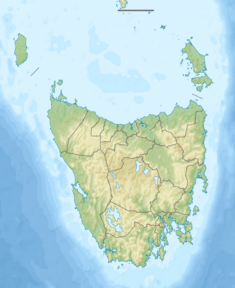Lake Margaret (Tasmania) facts for kids
Quick facts for kids Lake Margaret |
|
|---|---|
|
Location in Tasmania
|
|
| Country | Australia |
| Location | West Coast, Tasmania |
| Coordinates | 41°59′30.3″S 145°35′15″E / 41.991750°S 145.58750°E |
| Purpose | Power |
| Status | Operational |
| Opening date | 1918 |
| Owner(s) | Hydro Tasmania |
| Dam and spillways | |
| Type of dam | Gravity dam |
| Impounds | Yolande River |
| Height (foundation) | 17 m (56 ft) |
| Length | 243 m (797 ft) |
| Dam volume | 6,000 m3 (210,000 cu ft) |
| Spillways | 1 |
| Spillway type | Uncontrolled |
| Spillway capacity | 29 m3/s (1,000 cu ft/s) |
| Reservoir | |
| Creates | Lake Margaret |
| Catchment area | 21 km2 (8.1 sq mi) |
| Surface area | 170 ha (420 acres) |
| Normal elevation | 660 m (2,170 ft) AHD |
| Power station | |
| Name | Lake Margaret Power Station |
| Operator(s) | Hydro Tasmania |
| Commission date |
|
| Decommission date |
|
| Type | Conventional |
| Turbines |
|
| Installed capacity |
|
| Annual generation | 48 GWh (170 TJ) |
Lake Margaret is a special place in Tasmania, Australia. It includes a large concrete dam and the lake (or reservoir) it creates. This area is found on the west coast of Tasmania, near Mount Sedgwick.
The main reason Lake Margaret exists is to make hydro-electric power. This means using the force of water to create electricity. The Lake Margaret Power Station, located below the dam, uses water from the lake for this purpose.
The dam was built a long time ago, in 1918, by a company called the Mount Lyell Mining and Railway Company. Later, in 1985, another company called Hydro Tasmania took over looking after the dam, the lake, and the power station.
Contents
Building the Lake Margaret Dam
The Lake Margaret dam was finished in 1918. It was the very first gravity dam built in Tasmania. A gravity dam is a huge wall that holds back water using its own weight. This dam is made of concrete.
The dam wall stands about 17 meters (56 feet) high. It stretches for 243 meters (797 feet) across the Yolande River. The dam also has a special part called an uncontrolled spillway. This spillway lets extra water flow out safely when the lake gets too full.
In 1974, the dam wall was made even stronger. Workers used a method called prestressed anchors and filled any small cracks with grout. This helped make sure the dam would last for many more years. The Yolande River flows into Lake Margaret and then continues flowing out from the dam.
The Lake Margaret Reservoir
The lake itself, also called Lake Margaret, covers an area of about 170 hectares (420 acres). It sits high up, about 660 meters (2,165 feet) above sea level. The lake is surrounded by mountains like Mount Cyril and Mount Geikie.
The area that collects water for the lake is called its catchment area. For Lake Margaret, this area is about 21 square kilometers (8.1 square miles). Many smaller lakes and streams feed into Lake Margaret. These include Lake Barnables, Lake Phillip, Lake Monica, Lake Myra, Lake Magdala, Lake Martha, and Lake Mary. All these smaller water bodies help keep Lake Margaret full.
How Lake Margaret Generates Power
The main goal of Lake Margaret from the start was to create electricity. This electricity was used for the Mount Lyell mine, its railway, and the nearby town of Queenstown. Even though the mine is now closed, Lake Margaret still makes power today.
Between 1918 and 1930, the Mount Lyell Mining and Railway Company installed seven large generators. These generators used special wheels called Pelton turbines. Together, they could produce 8.3 megawatts of power.
In 1931, a smaller power plant was added. It used a different type of turbine called a Turgo turbine and could make an extra 3.2 megawatts of power.
The Power Station's Journey
When Hydro Tasmania took over in 1985, they continued to operate the power station. The water from Lake Margaret travels through a long, wooden pipeline, about 2.2 kilometers (1.4 miles) long, to reach the power station.
The smaller plant was closed for a while in 1994. However, it was completely updated and reopened in 2010. This update included a new penstock (a pipe that carries water to the turbine) and a new wooden pipeline. This shows how important Lake Margaret is for providing clean energy to Tasmania.


